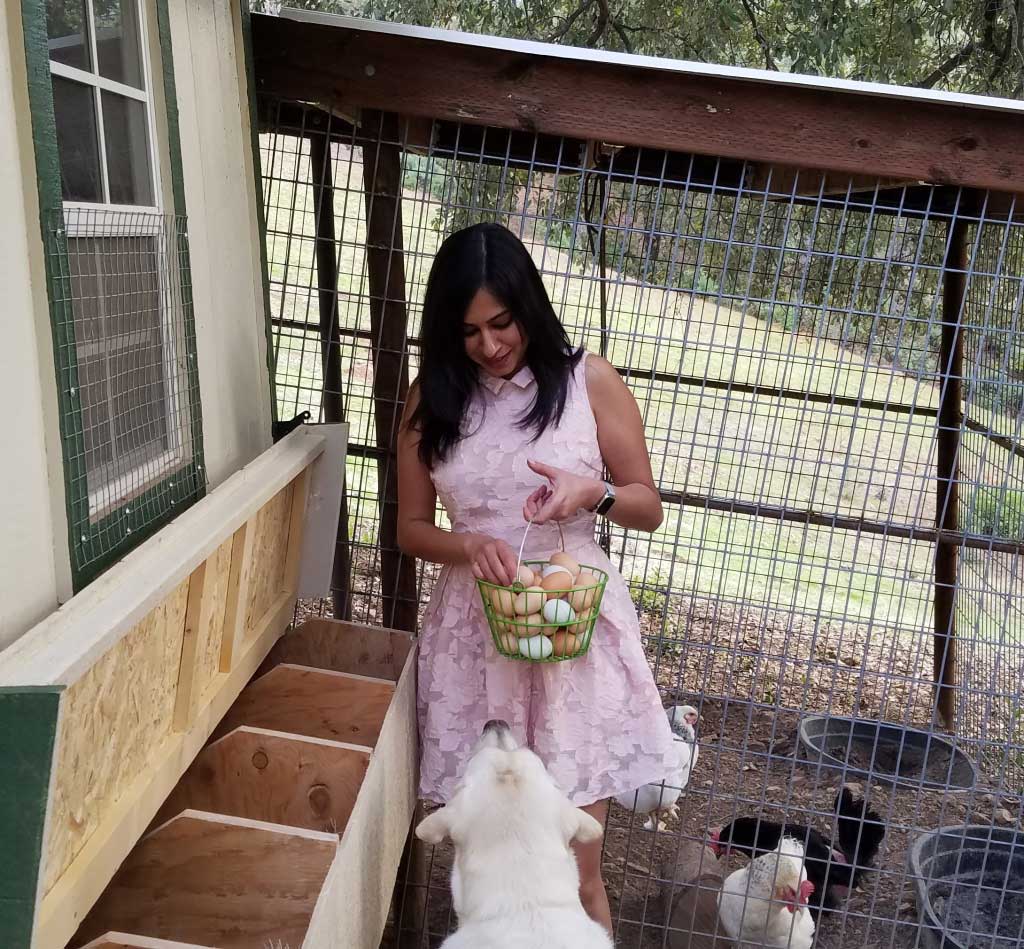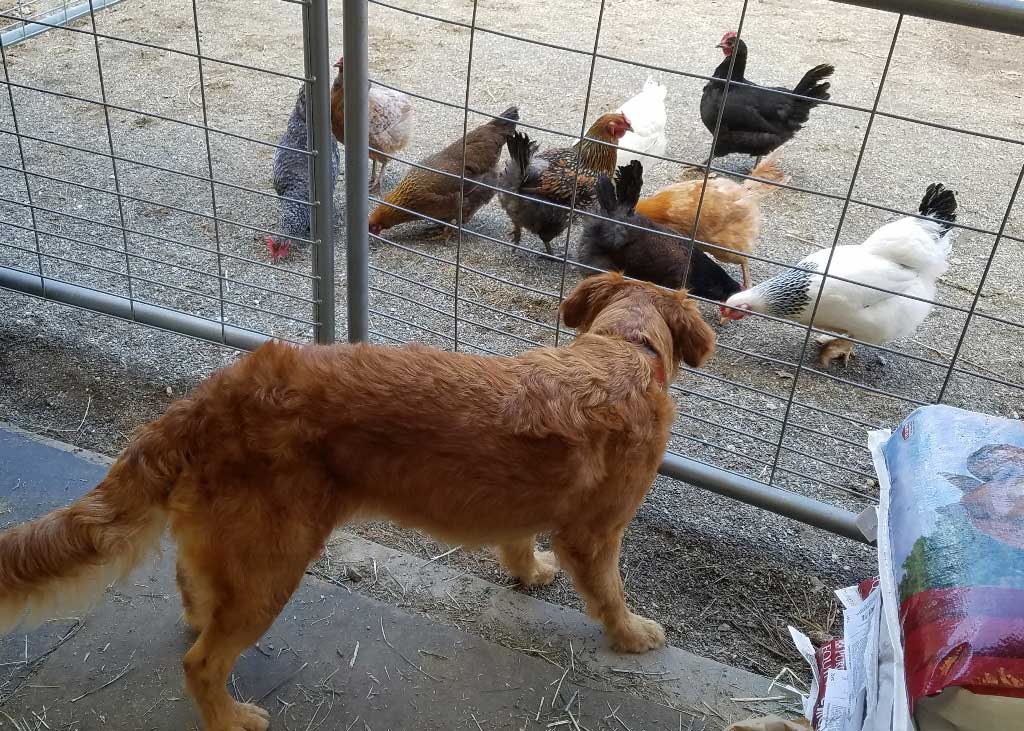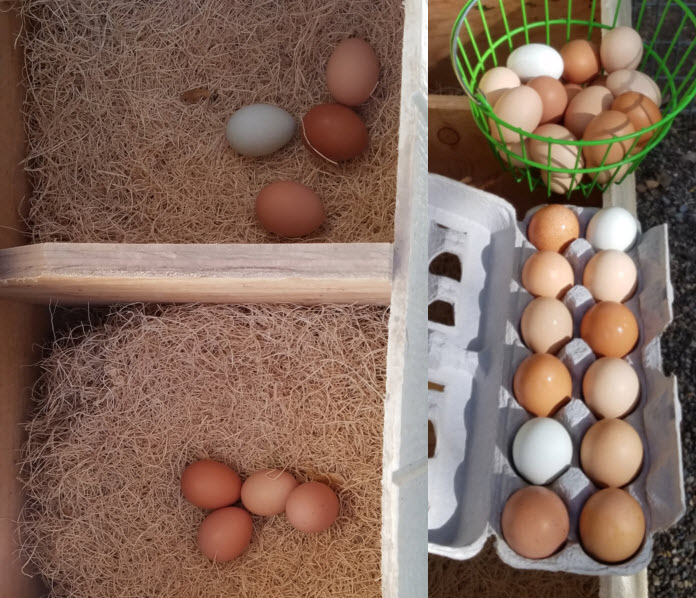Pasture-Raised Chickens Lay the Best Eggs!
By Cyndi | Apr 2021 - updated Sep 2023| Ranch Info
There are many blogs about chickens, often written by people who have been around fowl all their lives. We’ve been raising chickens for several years now (since 2017) and have learned a lot in a short time from a city-kid’s perspective – hopefully our “newbie” experiences are helpful for those thinking about getting started with chickens!
Chickens are excellent workers eating bugs and spreading manure in our horse pastures, PLUS providing daily eggs which is like Christmas every day opening the nest boxes to find our “presents” from the hens. The chickens also entertain our farm-stay guests letting people pet and feed them while guest dogs get an up-close experience. Watching our hens waddle-run during chicken races to their favorite treats is too funny. What's not to love about these girls?!
In return for their contributions, our chickens have a wonderful life with high quality food, enrichment toys, plenty of room to roam outdoors, and a large clean predator-proof coop at night. They even have a video showing their charmed lives.
Lifespan
Guests often ask us what the average life span of a chicken is, and the honest answer is “4 months” since very few chickens live out full lives. Though longer lives than meat chickens, commercial hens average 2 years before their egg production diminishes. Many backyard chicken owners will get one breed/color one year and another the next year to easily identify chicken age for maximized egg production and flock rotation. Deciding how you’ll manage aging animals is an important part of responsible pet ownership so be prepared before getting chicks. Our chickens are pets so hopefully some will live full lives to 5-8 years.
Preparing for Your First Flock: Coops, Runs, and More
 After quite a few hours of research preparing for our chickens, we’ve found chickens relatively easy to-care-for animals. We shopped coops and found a local builder through samples at a feed store – it’s been good that we got bigger and sturdier than the minimum since it makes for easier cleaning and expansion possibilities. There are lots of coops you can buy online and assemble at home as well as DIY plans.
After quite a few hours of research preparing for our chickens, we’ve found chickens relatively easy to-care-for animals. We shopped coops and found a local builder through samples at a feed store – it’s been good that we got bigger and sturdier than the minimum since it makes for easier cleaning and expansion possibilities. There are lots of coops you can buy online and assemble at home as well as DIY plans.
In terms of size of coop/run, there were a wide variety of recommendations but much had to do with size of chicken breed (we have the larger breeds and no bantams) and how much time the chickens will be spending inside the coop/run due to weather and access to additional space. I was surprised by the guideline of 1 nest box for 4-6 chickens but they do prefer to lay eggs in shared nests since by instinct hens know “clutches” can be kept warm all together. Our hens have daytime access to 10 acres of pasture (!) so we weren’t too concerned about the 5-10 square feet per bird if they live inside a run/enclosure, but the 2-3 square feet per chicken inside the coop guideline should be noted since many of the kit coops quote more birds than I think can comfortably be in the coop for full-sized breeds. Seeing my hens choose to roost close to each other at night rather than spread out on additional rails illustrated that chickens don't need much coop space if spending most of their time outside, especially with our relatively mild California temps (though we do have brooder/heater in winter and fans/misters in summer to provide total comfort for my spoiled girls).
Hens vs Roosters. We got our first flock of chickens as 8-week-old “pullets” so they were beyond the fragile chick phase. Though now closed, the Poultry Palace in Placerville was a great help with our intro to chickens and demonstrated how to catch/hold a chicken. At 8-weeks, the team at the Poultry Palace could “sex” for hens and we didn’t want any roosters. Roosters can be good for a bit of protection and keeping the peace among the hens, but we didn't want the crowing noise nor fertilized eggs (note some city ordinances won't allow roosters). I wanted a variety of breeds to experience traits of different favorites and for colorful egg baskets – we’ve really enjoyed the variety and have continued this tradition with additional chicks.
Raising Chicks
One of our early learnings was that chickens are much more fragile than our dogs and horses (who have vets on speed-dial) – even though we were quick to recognize when a chicken wasn’t acting 100% healthy and did what we could for her quickly, it’s common to lose some birds to various illnesses. We also had a few rounds of predator issues we had to address (more below). Losing some older hens gave me an excuse to add to chicks to my flock!
Many people buy chicks from their local feed store, but I decided to buy day-old mail-order chicks in 2019 (IdealPoultry), 2020 and 2023 (MyPetChicken). These large hatcheries offer lots of breed variety and have a high success rate for “sexing” chicks (most say 80-90% depending on breed but we've had 100% female accuracy). They also offer Marek’s vaccines which I prefer for pet chickens. I followed all the hatcheries’ recommendations to ensure warm transport so didn’t lose chicks due to cold shipping. The babies are still existing off their egg nutrition during shipping, but arrive thirsty and hungry, so I was prepared to dip their little beaks in water and incent them with special chick feed.
It was lots of fun watching the baby chicks grow and learn! I captured the daily growth of my 2023 chicks with highlights in the progress video above from days-old to 15-weeks. Though I was checking daily for “pasty butt”, I learned with one of my first 2019 chicks that you may need to check/clean more frequently so have been diligent about any possible poop issues since then. Like most animals, watching for basic drinking, eating, defecating, and normal movement usually highlights health problems. One chick had “crooked toes” and we successfully splinted them with vet wrap so she grew up with normal feet that could hold onto a roost bar.
Hand-raising chicks was such a special experience and allowed them to bond more closely with me. They spent their first 4-8 weeks in our house/garage where we could provide a warmer environment and I got to see their individual personalities develop, which also solidified their naming. They all know my voice and come running for food when they hear it. A few of my girls were fliers and would regularly perch on my shoulder and head. Troy looked forward to the chicks being old enough to move out of his garage and down to the barn.
We built a chick coop/run next to the big hens’ coop so the chicks and hens could be separated while getting to know each other. We’ve successfully introduced many animals over the years but are always delighted when our plans result in non-eventful integration. When the pullets were closer to adult hen size (12-16 wks), we let them meet in the pasture for a couple of weeks, and then did the farmer’s trick of moving the young one to the big coop at night when everyone was sleepy/roosting. Everyone woke up in the morning with their new flock. Our hen coop cam showed any pecking order issues which we quickly addressed with some additional lower roost bars for the less-dominant girls.
Predator Issues
 Though llamas are known for guarding sheep and goats, we’ve found they don’t bond with our chickens so don’t step in to protect them. We even have one barn camera video of a coyote running a few feet in front of one of our llamas on his way to the chickens! For a while, we had one llama who was very territorial and would raise an alarm if a predator put one paw in her pasture. Sadly, we lost that llama so experienced what most people must deal with and had to come up with other predator prevention methods.
Though llamas are known for guarding sheep and goats, we’ve found they don’t bond with our chickens so don’t step in to protect them. We even have one barn camera video of a coyote running a few feet in front of one of our llamas on his way to the chickens! For a while, we had one llama who was very territorial and would raise an alarm if a predator put one paw in her pasture. Sadly, we lost that llama so experienced what most people must deal with and had to come up with other predator prevention methods.
Our coop and chicken run were built to be predator proof so that is the first recommended step in defense. We are big fans of our coop auto-door that lets our hens in/out at dawn/dusk (after we made sure they were trained to go in at night to roost). Our main predator problems were at dawn and dusk when some predators are still hunting, and our chickens were anxious to get out for bugs. We solved that with a second timed door on the larger wire run that opens mid-morning, and we close it after headcount at barn animal dinnertime feeding. We hadn't lost any chickens for over a year since started this new routine so decided our hens could still enjoy many hours of free-range pasture during the safest time of the day. Unfortunately, we occasionally get mid-day-hunting coyotes so have to stay vigilant to protect our free-range flock. Our chickens are not forced to leave the run but rather they choose some risk to experience life beyond 4 walls (not to get too philosophical about risks/rewards and quality of life that applies to more than just chicken!) – take a look at these photos to see the happy birds.
Eggs, Eggs, Eggs!
 Our guests often comment about how much better our chickens' eggs taste than anything they find in the store. One guest's post said it perfectly "All those brands that claim 'farm fresh eggs' have nothing on this! I actually picked out freshly laid eggs! It was so fresh that it was still warm!"
Our guests often comment about how much better our chickens' eggs taste than anything they find in the store. One guest's post said it perfectly "All those brands that claim 'farm fresh eggs' have nothing on this! I actually picked out freshly laid eggs! It was so fresh that it was still warm!"
Not only are our ranch eggs fresher, but the eggs also taste better since our hens have the freedom to forage outdoors every day giving them sunshine, exercise, and a more varied natural diet. We usually provide a dozen eggs in the refrigerator for guests to enjoy, and guests also help us collect more fresh eggs each day.
We find the “double yolkers” the most interesting eggs and can identify them by the extra long eggs that sometimes occur when young hens’ bodies are finding a rhythm with their first eggs. Eggs generate lots of interest from our guests so here are our most common Q&A’s:
- Different colors of shell don’t affect the egg taste (white eggs are just as good as brown ones because of the same excellent environmental conditions our hens have on their free-range pasture). We love the egg variety and especially enjoyed one guest’s photo of their “green eggs and ham”!
- Different breeds lay different colored eggs, and an individual chicken will lay the same color of egg all her life (though the eggs can appear lighter as she lays larger eggs in her second season). The breed is also key for the size of the eggs – one of our smallest chickens (a 4-lb Leghorn) typically laid the largest and most eggs which is why they are such a popular breed for egg producers.
- On average, chickens lay an egg every 2 out of 3 days. With young guests whose parents want an educational farm-stay visit, I use this as a math fractions story problem when collecting eggs … with 9 chickens, I would expect 6 eggs/day on average so we can see whether above or below average (my mom was a math teacher so I try to make learning fun!).
- Longer spring days have the highest egg production after short winter days (which is why producers focused on more eggs will leave lights on in the chicken coop – we don’t). Chickens stop laying during fall “molt” when their bodies are doing extra work growing new feathers instead of eggs and also when a hen gets “broody” and sits on the nest for 20 day cycles trying to warm/hatch her clutch of eggs.
- Many guests ask about our chickens laying eggs without a rooster. Adjusting my answer based on age of the listeners, the adults quickly get the comparison with humans also generating many eggs that don’t get fertilized with monthly ovulation. Similarly, chickens prepare for the possibility of a fertilized egg and release it either way almost daily. No wonder farm kids don’t need any “birds and bees” talks!

